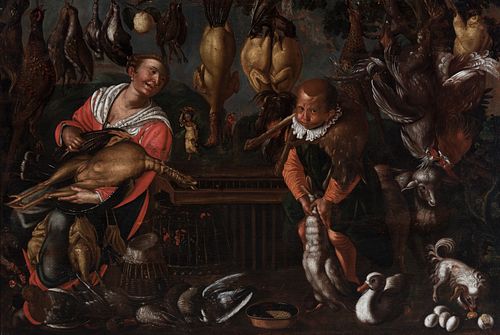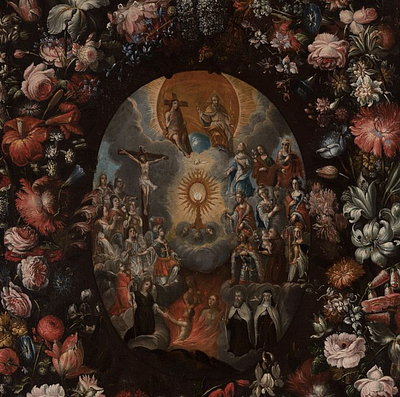Attributed to VICENZO CAMPI (Cremona, Italy, 1536 - 1591). "Kitchen still life". Oil on canvas. Re-coloring of the nineteenth century.
Lot 84
About Seller
Setdart Auction House
Carrer Aragó 346
Barcelona
Spain
Setdart Subastas was born in 2004 and is currently the first online art auction in Spain with solidity, prestige and reliability guaranteed by our more than 60,000 users. Setdart has a young, dynamic and enterprising team ready to successfully manage the purchase and sale of art works through custom...Read more
Estimate:
EUR€22,000 - EUR€24,000
$23,655.91 - $25,806.45
Absentee vs Live bid
Two ways to bid:
- Leave a max absentee bid and the platform will bid on your behalf up to your maximum bid during the live auction.
- Bid live during the auction and your bids will be submitted real-time to the auctioneer.
Bid Increments
| Price | Bid Increment |
|---|---|
| EUR€0 | EUR€10 |
| EUR€200 | EUR€25 |
| EUR€500 | EUR€50 |
| EUR€1,000 | EUR€100 |
| EUR€3,000 | EUR€200 |
| EUR€5,000 | EUR€500 |
| EUR€10,000 | EUR€1,000 |
| EUR€20,000 | EUR€2,000 |
| EUR€50,000 | EUR€5,000 |
About Auction
By Setdart Auction House
Jul 14, 2021
Set Reminder
2021-07-14 06:30:00
2021-07-14 06:30:00
America/New_York
Bidsquare
Bidsquare : OLD MASTERS
https://www.bidsquare.com/auctions/setdart-auction-house/old-masters-7202
Setdart Auction House sofia@setdart.com
Setdart Auction House sofia@setdart.com
- Lot Description
Attributed to VICENZO CAMPI (Cremona, Italy, 1536 - 1591). "Kitchen still life". Oil on canvas. Re-coloring of the nineteenth century. It presents repainting, restorations and frame of later period. Size: 145 x 216 cm; 172 x 241 cm (frame). In this work is represented, in a composition centered in the foreground, a costumbrista scene starring a man and a woman inserted in a large still life that is arranged along the entire pictorial surface. The author picks up from outside, barely visible due to the amount of elements that make up the composition, in which a man and a woman hold birds in their hands, indicating that they are performing. The painting is part of the aesthetic current that represents the customs, one of the genres that enjoyed greater development in the baroque school. Thus, the space is clearly defined and meticulously described, and the figures are represented at a large size. Both the two people, as well as the animals that are found throughout the composition. Although competing with them in prominence is the group of animals that are distributed throughout the surface, posed as a real independent still life. This shows how the author has combined two different themes in the same piece, making them coexist in harmony. Both for the theme and the way of approaching it, this work can be directly related to the figure of the Italian painter Vincenzo Campi, whose realism is understood by critics as an important precedent for Caravaggio's painting. Belonging to a family of painters and architects, Vincenzo developed his apprenticeship in the domestic environment in Cremona. He collaborated with his brothers Giulio and Antonio and his earliest known works, dating from the 1560s, show few original details. Gradually, Campi's painting became more interested in the representation of genre scenes, which portray everyday life with greater naturalism. This approach to the reproduction of more realistic figures is transferred to his religious work, as evidenced by the "Crucifixion" (Prado), which has been said to have been seen by the young Caravaggio. At the same time, Vincenzo Campi knew how to incorporate into his painting the novelties that were taking place in Venetian painting, emphasizing color and chiaroscuro. In this way, he followed several parallel lines in his work. On the one hand, he continued to compose everyday scenes, sometimes including humorous themes influenced by Flemish painters such as Beuckelaer and Aertsen. In addition, he carried out perspectival decorations such as those in the frescoes of San Paolo Converso in Milan. Finally, he continued to produce altar paintings in which he developed a naturalism of such great intensity that it has been seen as the closest precedent to the work of Caravaggio. The work we present here could be included in the group of Flemish-influenced genre scenes, and in fact has very similar characteristics to those of the canvas "The Cheese Eaters", preserved in the Museum of Fine Arts in Milan. In this work we also see a composition in the foreground, with buffoonish characters placed in the foreground against a dark background. One of them, moreover, appears as here holding a ladle.
- Shipping Info
-
In-house shipping available. Please inquire at admin@setdart.com.
-
- Buyer's Premium



 EUR
EUR CAD
CAD AUD
AUD GBP
GBP MXN
MXN HKD
HKD CNY
CNY MYR
MYR SEK
SEK SGD
SGD CHF
CHF THB
THB


















